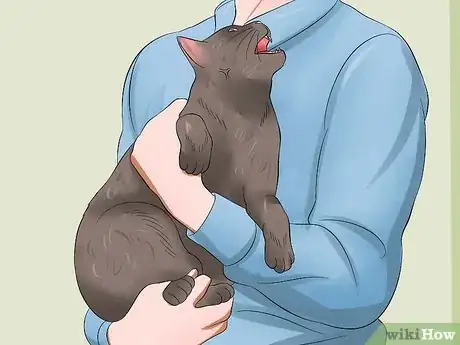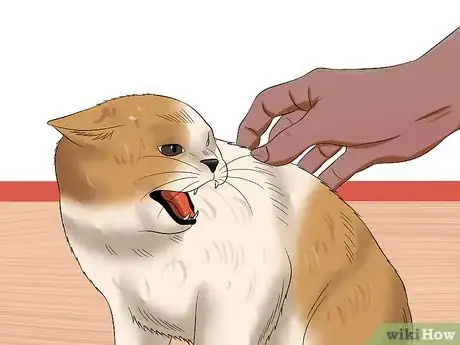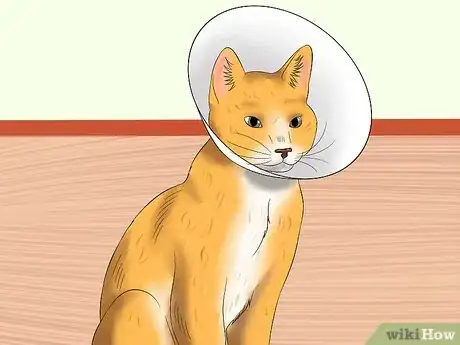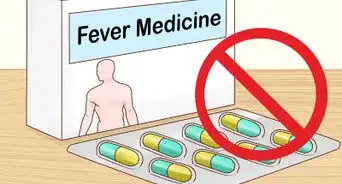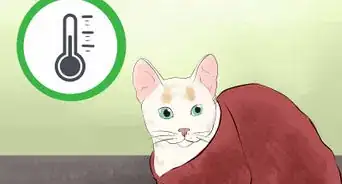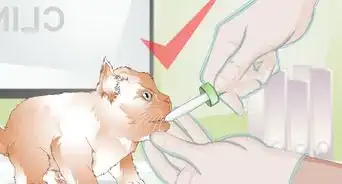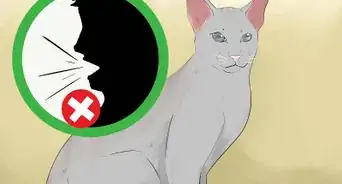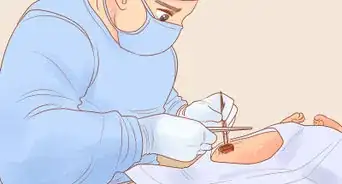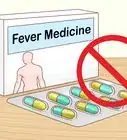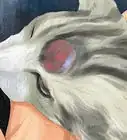This article was co-authored by Natalie Punt, DVM. Dr. Natalie Punt is a Veterinarian and the Founder and CEO of mPet- a smart phone app for pet owners to store, manage and transfer their pets medical records and health information. She specializes in small animal emergency and general medicine and veterinary practice economics. Dr. Punt holds a BS in Biochemistry and Molecular Biology from The University of California, Davis, an MS in Biochemistry from The University at Buffalo, and a DVM from Western University of Health Sciences.
This article has been viewed 42,847 times.
As a cat owner, it is your responsibility to look after the health and welfare of your pet. An important part of this responsibility is recognizing when your cat is in pain and seeking professional veterinary care to alleviate that pain. Unfortunately, cats are masters at masking pain, as it is ingrained in them not to appear weak or vulnerable.[1] Although spotting the signs of pain in your cat is tricky, it's not impossible if you pay close attention to their behavior and character.
Steps
Looking For Behaviors That Signal Pain
-
1Look for changes to your cat's routine. Your cat has regular habits that it sticks to every day. This might include what time it gets up, how it greets you when you come home from work, how it asks for food, and how often it goes to the bathroom. Be alert for changes in these habits, especially when they involve the cat becoming more withdrawn.[2]
- The changes are usually for the worst, such as eating less, not getting up to greet you, hiding away, or toileting outside the litter box.[3]
- Your cat may also enter and exit their litter box more than usual.[4]
- These changes are not specific for pain, so just because the cat hides away doesn't automatically mean they are in pain, but it does mean something is wrong and you need to look for other signs and clues as to what the problem could be.
-
2Pay attention if the cat abandons beloved activities. You should be used to what's normal for your cat, such as which toy it likes to play with and for how long, or which is its favorite sleeping spot and how long it spends there. Changes in favorite activities can be a clear sign that your cat is in pain.
- For example the cat in pain may find it difficult to rest and so it paces around instead of curling up to sleep. It may repeatedly settle and then get up again. Or perhaps it adopts one posture and then holds it whilst looking stiff and tense.
Advertisement -
3Look for difficulty with movement. The cat may have difficulty getting up from a sitting or lying position. Once it starts moving be alert for a limp, and look to see which leg the cat is limping on.
- Even lack of movement in the ears can signal a problem. The ears would normally move to catch fleeting sounds in the environment. Often a cat in pain has more fixed ears that may well be flattened against its head.
- If your cat is experiencing skeletal pain, they may not jump as easily as they used to. They also may not want to go up and down stairs, or jump onto your bed.[5]
-
4Watch the cat's breathing. This is easily done by fixing on one spot of hairs on its chest and watching them move in and out. A cat usually takes 20-30 breaths a minute, whereas a cat in pain may take rapid shallow breaths. In extreme cases the cat may breath with its mouth open, which is not something cats do normally unless they are extremely hot.
-
5Pay attention to how the cat reacts when picked up. Does it cry out, wince, or scrabble to get away as if picking it up has hurt it? A change of reaction from what is normal can indicate a problem, especially if other signs are present.
Assessing Changes to Your Cat's Character
-
1Determine if the cat is acting out of character. A cat that is normally sweet-tempered who becomes irritable may well be in pain. This is a giveaway that there is a problem. The placid cat that suddenly turns aggressive, hisses, and spits rather than let you pet it is probably experiencing pain.
- Be alert for a friendly cat, that changes character backs away, arches their back, hairs erect, dilated pupils, ears flattened back, hisses and spits. These are all signs of aggression.
- Alternatively, you may have a feisty cat who suddenly becomes withdrawn and starts hiding.
- Indeed, the cat who stops grooming may be in pain.
-
2Take a look at the cat's face and posture. The signs are subtle but a cat's facial expression can tell you a lot about whether it is stressed or not. This is important because a cat in pain is also a stressed cat, and stress signals can be a vital clue.
- Look for a worried or tense expression on the cat. This could include a furrowed brow or a vacant stare. The pupils are likely to be large and dilated, whereas a cat at rest in normal lighting conditions should have slit-shaped pupils.
-
3Notice changes in vocalization. Some cats may cry more and vocalize when they are in pain.[6] However, many go the other way and become quiet and withdrawn.
- Be aware that purring does not always mean the cat is happy. Purring can comfort the cat and so even a distressed cat may purr to itself in order to feel reassured and a bit better.[7]
Treating Pain
-
1Identify where the cat's pain is coming from. Common causes of pain include dental discomfort, bite wounds, inflamed eyes, sprains, fractures, pancreatitis, cystitis, ear infections, skin infections, bone disease, cancer, and arthritis. Your veterinarian may be able to figure out why your cat is in pain if you can't.
- If your cat has had recent surgery, then you will want to be sure it is not in pain while healing. Make sure it is getting the necessary medication to recover without pain.
-
2Make your cat as comfortable as possible. Some cats will shy away from affection, almost as though they expect petting to cause them discomfort. However, other cats go the other way and seek extra attention, as if needing reassurance.[8]
-
3Seek professional veterinary treatment for the pain. Ask your vet about a safe but effective pain relief medication. There are a variety of these that can be prescribed to meet your cat's pain management needs.
- In addition to pain management, your veterinarian should be treating the underlying cause of the pain. If your vet can't find the source, go to another vet for a second opinion.
- Never treat the pain at home with human drugs. Cats metabolize drugs very differently to people and the medication we have in our medicine cabinets can be toxic to cats.
-
4Stop your cat from self harming. A cat with a low grade or nagging pain, may try to distract or comfort itself by excessive licking, which results in broken hairs and a moth-eaten look to its coat. Some cats may do themselves actual harm and bite at an area that is painful, as if they perceive there is something attacking their body and they wish to get rid of it.
- If this is the case consult with your vet about ways to stop the cat from licking or biting itself. One solution is to put a cone on the cat until the pain is eliminated.
- Sometimes the cat will lick the area that is painful, for example a sore joint, other times it will lick an area that is not the source of pain but is just soothing itself. In these cases the cat may lick an easy to get to spot, such as a paw or its belly.
Expert Q&A
-
QuestionDo cats meow if they are in pain?
 Pippa Elliott, MRCVSDr. Elliott, BVMS, MRCVS is a veterinarian with over 30 years of experience in veterinary surgery and companion animal practice. She graduated from the University of Glasgow in 1987 with a degree in veterinary medicine and surgery. She has worked at the same animal clinic in her hometown for over 20 years.
Pippa Elliott, MRCVSDr. Elliott, BVMS, MRCVS is a veterinarian with over 30 years of experience in veterinary surgery and companion animal practice. She graduated from the University of Glasgow in 1987 with a degree in veterinary medicine and surgery. She has worked at the same animal clinic in her hometown for over 20 years.
Veterinarian Cats do meow and purr when in pain. Experts believe this is because the cat finds it comforting, so it's never safe to assume a cat is not in pain because they are vocalizing.
Cats do meow and purr when in pain. Experts believe this is because the cat finds it comforting, so it's never safe to assume a cat is not in pain because they are vocalizing. -
QuestionWhat can you give a cat for pain?
 Pippa Elliott, MRCVSDr. Elliott, BVMS, MRCVS is a veterinarian with over 30 years of experience in veterinary surgery and companion animal practice. She graduated from the University of Glasgow in 1987 with a degree in veterinary medicine and surgery. She has worked at the same animal clinic in her hometown for over 20 years.
Pippa Elliott, MRCVSDr. Elliott, BVMS, MRCVS is a veterinarian with over 30 years of experience in veterinary surgery and companion animal practice. She graduated from the University of Glasgow in 1987 with a degree in veterinary medicine and surgery. She has worked at the same animal clinic in her hometown for over 20 years.
Veterinarian Truly the only safe medications for cats in pain are those supplied by the vet. Most household pain killers are highly toxic to cats, and you would end up with a pained cat that has also been poisoned.
Truly the only safe medications for cats in pain are those supplied by the vet. Most household pain killers are highly toxic to cats, and you would end up with a pained cat that has also been poisoned. -
QuestionWhat are the symptoms of a cat dying?
 Pippa Elliott, MRCVSDr. Elliott, BVMS, MRCVS is a veterinarian with over 30 years of experience in veterinary surgery and companion animal practice. She graduated from the University of Glasgow in 1987 with a degree in veterinary medicine and surgery. She has worked at the same animal clinic in her hometown for over 20 years.
Pippa Elliott, MRCVSDr. Elliott, BVMS, MRCVS is a veterinarian with over 30 years of experience in veterinary surgery and companion animal practice. She graduated from the University of Glasgow in 1987 with a degree in veterinary medicine and surgery. She has worked at the same animal clinic in her hometown for over 20 years.
Veterinarian A dying cat may often hide away and seek a solitary place. In addition, they are unlikely to eat and will quickly become dehydrated. Check for this by lifting the scruff and letting go. If it sinks back slowly, the cat is dehydrated.
A dying cat may often hide away and seek a solitary place. In addition, they are unlikely to eat and will quickly become dehydrated. Check for this by lifting the scruff and letting go. If it sinks back slowly, the cat is dehydrated.
References
- ↑ Natalie Punt, DVM. Veterinarian. Expert Interview. 15 February 2022.
- ↑ http://www.catbehaviorassociates.com/10-signs-that-your-cat-may-be-in-pain/
- ↑ Natalie Punt, DVM. Veterinarian. Expert Interview. 15 February 2022.
- ↑ Natalie Punt, DVM. Veterinarian. Expert Interview. 15 February 2022.
- ↑ Natalie Punt, DVM. Veterinarian. Expert Interview. 15 February 2022.
- ↑ Natalie Punt, DVM. Veterinarian. Expert Interview. 15 February 2022.
- ↑ http://www.catbehaviorassociates.com/10-signs-that-your-cat-may-be-in-pain/
- ↑ http://www.catbehaviorassociates.com/10-signs-that-your-cat-may-be-in-pain/
About This Article
One easy way to tell if your cat is in pain by looking for negative changes in its behaviors, such as eating less, not greeting you, or not using the litter box. Watch as it gets up from a sitting or lying position, since a hurt cat will have difficulty standing up or might have a limp once it starts walking. When it’s in the lying position, watch its breathing by staring at one spot of hairs and watching them move in and out. Normally, a cat will take 20-30 breaths a minute, but a cat in pain may take rapid, shallow breaths. For more help from our Veterinary co-author, like how to stop your cat from self-harming, scroll down.





